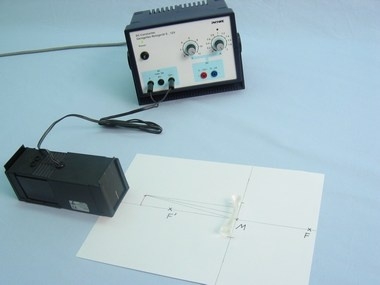Principle
The aim of this experiment is to determine the intersection point of selected light beams incident on a planoconcave lens and thus demonstrate the possibility of image formation. First of all, in this experiment, only the course of selected light beams is observed. Only during the evaluation does the possibility of image construction with the aid of the backward extension of the light beams become apparent to the students.
In this way, a starting point is given for a discussion about the role of mathematical aids in understanding physical phenomena. A confirmation of the lens equation, in an example is not the least important factor in making it clear to the students that a significant advantage is given to the user when he can make precise statements about the optical properties of its components even before the construction of an optical apparatus.
In terms of the level of experimental skills and understanding which are acquired by the students, the experiment is quite demanding. No real image is produced, as the intersection point of the backwards extension of the refracted light beams lies in front of the planoconcave lens.
In this way, the teacher is given an opportunity to explain the nature of virtual images to the students and to deepen their understanding of virtual images on flat and curved mirrors.
Benefits
- Multifunctional light box - All-in-one: Can be used for geometric optics on the table, colour mixing and on an optical bench
- Extension with others sets at anytime, no additional light sources needed, recognition value for students
Tasks
Are images also formed by concave lenses? Investigate the image formed by a concave lens using selected light beams.



